
Main
Accoucheur's
Antique
7xCoke
Home
Medical Antique Collection

|
The introduction of anesthesia in Obstetrics was slow because of the opposition of the clergy and the medical profession. In 1591, Eufama McAlayne of Edinburgh was buried alive on Castle Hill for begging a potion from a midwife Agnes Sampson to relieve her labor pains. Pain in labor has been considered as a natural atonement of women for the original sin commited in the garden of Eden. Hence, most prominent clergymen objected to the administration of anesthesia in a parturient mother. Leading minds in medicine like Meigs, Hodge, Bedford, were against the use of anesthesia in midwifery. They believed that, "Self respecting women should not submit to the stupor or drunkeness produced by anesthetics!" |
 |
 |
|
Circa 1850 |
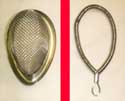 |
 |
|
Circa 1880 |
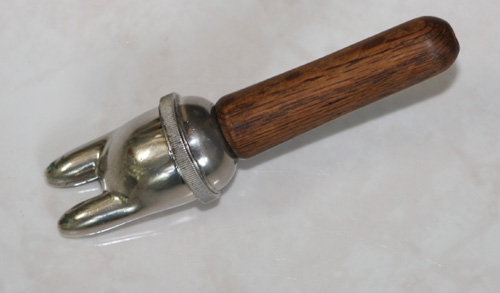 |
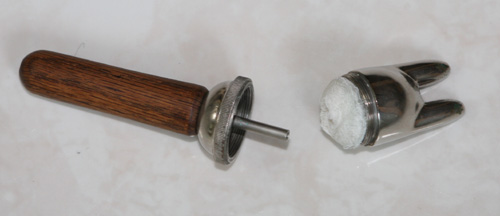 |
|
Reynold's Obstetric Inhaler Circa 1910
It is a self administered ether
inhaler during labor. The body is made of nickel plated
brass. The handle is made of oak.
|
 |
Ether Inhaler. |
 |
 |
|
Bloodletting
in pregnancy was part of prenatal care and was a common practice.
Up to 300 ml (10 oz) of blood was taken at least once in mid
pregnancy. A bleeding bowl shown below catches and measures the
amount of blood let go. It was considered that bloodletting would
remove the phletora of blood
that makes the process of labor
difficult. The superficial veins of the arm more than in the legs
were mostly cut. Rarely leeches were utilized. In early 1800's bloodletting was used for pain relief of labor. Dewees attributed pain in labor to abnormal biological conditions produced by civilization; loss of power in the longitudinal muscular fibers (Right photo in red), over the circular fibers of the uterus (Right photo in blue). The resistance of the circular muscle fibers, could be overcome by bleeding the patient. The sharp knife was snapped into the vein of a laboring patient with a spring. The spring lancet is a small brass instrument measuring 5.5 x 3 cm. with leather case. Circa 1780. |
 |
 |
|
Circa 19th Century Turtle shell cover. (L 9.5 cm) |
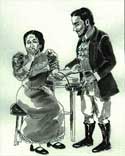 |
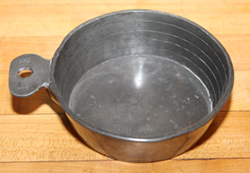 |
|
Circa 18th Century
A rare
authentic pewter
bleeding bowl used to catch blood in bloodletting procedures in the
18th
Century. There are four rings on the inside of the bowl denoting
4 ounces (120 cc) each. Bloodletting was used to rid the body of
yellow or black bile or blood poisons. Eclampsia, formerly known
as Puerperal Convulsions was thought to be caused by body toxins.
The patient was bled of 16 to 30 ounces (1 liter), until she was on the
verge of shock. Puerperal Convulsions was almost always fatal to
the pregnant patient.
Art work by Rey Evangelista
|
 |
Circa 19th Century Often times general bloodletting was followed by the use of leeches for treatment of incapacitating menstrual cramps. The leeches were applied within the vulva, or on the groins. (Meig's Midwifery, 1838). The photo on the left is a hand blown smooth glass carrier used to store the blood suckers. The lip of the glass carrier is everted for tying a cloth to keep in the leeches. (H 7 cm) |
 |
Circa 18th-19th Century Eclampsia, formerly called the
puerperal convulsions,
was thought to be caused by blood borne toxins, thus the name
"Toxemia".
The toxins originated from the uterus causing swelling and inflammatin
ot the brain of pregnant women causing her to have seizures.
Bloodletting
was used to unload the vessels of the brain (Ramsbotham, 1865). The
temporal
artery or the jugular vein was cut by a folding fleam or knife
bleeder.
The bloodletting device was used around the 18th and 19th
Century.
It is made of brass with a tortoise shell shield. |

All statements in this
web page
regarding date, age, and origin are statements of opinion. All
photos
and materials on this web page are protected by copyright laws.
Please
obtain direct permission from to
use any and all materials on this site, including photographs and
drawings.
to
use any and all materials on this site, including photographs and
drawings.